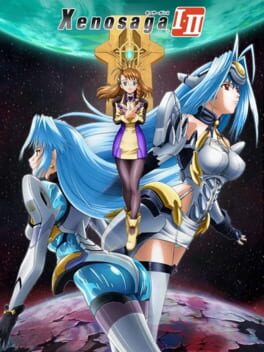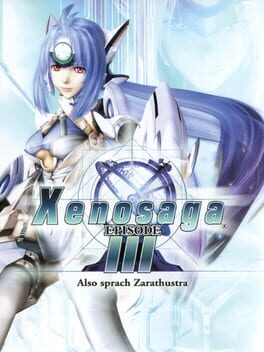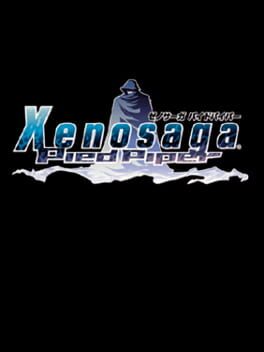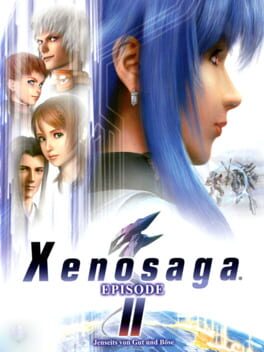

Xenosaga I & II is a combined remake and retelling of Xenosaga Episode 1 and 2 redesigned for the Nintendo DS. The story changes were handled by the creator of the series. The game changes large parts of the storyline in Episode 1 while following the elements established in the original game. This includes adding new characters and changing how some scenarios play out. Changes in Episode 2 were much larger as the main character perspective of the game was switched from Jr. to Shion to match up with Episode 1 and 3. Some characters are removed from the story or have their fates changed or revealed. Some dungeons are removed, edited, or replaced. It also answers some questions that the original did not as you follow a different path through the same overall story. It also changes the combat mechanics of Episode 2 to match Episode 1.
Also in series
Reviews View More
I've never really revisited Xenosaga's story before. It's fun experiencing Xenosaga in such an unorthodox way, albeit it's not quite as grandiose as the PS2 cutscenes. Xenosaga 1 honestly felt like it went by incredibly fast, and I mean that in a good way. Most scenes felt like they got to the point quickly, though some segments did drag on a little bit. Xenosaga 2 had three chapters with absolutely 0 gameplay and I can't think of anything more accurate to Xenosaga 2. The new story elements/changes are pretty neat, if not all that significant overall. A few new characters here and there which don't really come back for Xenosaga Episode III, among certain character's roles becoming more significant in specific scenarios. Extra backstory for some characters, etc. There is a very nice new scene in the ending of Episode II. The game also has more references to Pied Piper both in main story cutscenes and NPC dialogue, which is INCREDIBLY nice to see.
That said, I feel the pacing was ultimately dragged down by the substory segments which mostly offer flashback sequences to explain part of the backstory of certain characters, or to show events from a different perspective. Almost all of these were portrayed during the main story of the PS2 versions, however; some of these originally featured gameplay segments, while the DS substories do not.
For instance, when Ziggy goes to save M.O.M.O. at the very beginning of Episode I, you play through a dungeon in the PS2 version, while the DS version presents it purely as a flashback and dialogue only. I don't mind these gameplay segments being cut since it lends itself to a much more tightly-paced game overall, however I do take issue with how frequent substories are and how intrusive they can feel to the overall experience.
You often get prompted to view a side story after a story cutscene in which it unlocks. These also offer bonus items as you finish reading them. The issue comes with how frequent these can be at times, and intrusive they can be to the pacing of the game. They are strictly visual novel segments, and even if I'm reading at half speed in Japanese they are LONG. It plays so much like a visual novel that I end up wishing for an option to save during cutscenes, this game really needed it.
That said, they ARE all technically optional, and can be read from the menu later on at any point throughout the game. I just felt reading them as they came up was the most natural way to consume them, since they give you a prompt to read them immediately upon unlock.
There are some story segments where you have a main story scene, a substory, followed by more main story and then ANOTHER substory, with no break or way to save in between. Many of these substories are often longer than the main story segments that precede and succeed them, making them incredibly worth the read but kinda out of place in a way. The substories are certainly substantial in terms of length but viewed in the context of when the game prompts you to view them, they feel like they only serve to break the pace rather than give you insight into a new perspective or character's backstory.
The writing in this version of the story is significantly less messy than the PS2 versions, and honestly I appreciate the overall story of the trilogy a whole lot more after playing this. Like, it's a lot of info but Jesus Christ (literally) I've never appreciated Xenosaga as much as this before. It's an incredible story and I've honestly enjoyed re-experiencing this story. Everything feels interconnected, somehow incredibly naturally despite the nature of the story. Incredibly glad I experienced this story a second time with the DS version of these games.
Visually, you can tell this game was fairly cheaply-made with a lot of effects looking laughably like mid-2000s meme effects, character animation being almost nonexistent and reusing assets from the PS2 games... but honestly I found this added a lot of charm to the experience. There are a number of times the game just features short FMVs of the PS2 version's cutscenes, which made me laugh every time I saw one. A few voice lines are reused from the Japanese versions of these games as well, although they are incredibly compressed in this game. You can tell where they cut corners, but I found it so charming in a way that I didn't mind one bit.
This game has a completely unique soundtrack to the PS2 versions of these games by Kosuke Yamashita, which is VERY good. I mainly know Kosuke Yamashita for his work on the Nintendo Switch Presentation Trailer music for The Legend of Zelda: Breath of the Wild, which is oddly specific I know, but I was pretty impressed by his work on this DS game. There are no real rearrangements of the PS2 music done for the game, so with me being a Xeno series music nerd, it's a nice feeling to discover new Xeno music for the first time. A personal highlight track for me would be the E.S. Battle Theme. It is very nice to play Episode I with any background music at all. The new music all feels very fitting for Xenosaga's overall tone, albeit I do admit it does get repetitive after a while given how often tracks are reused, and that you'll be listening to most of them for quite a while during the visual novel-like cutscenes. The music implementation could have been improved as well, as there are many moments where tracks only play for 5-10 seconds before getting cut off to play another song (this happens particularly often during PS2 cutscene FMVs). But overall, I do quite like this soundtrack and feels like it deserves its place as a Xenosaga soundtrack.
As for the gameplay, I honestly think it might be the snappiest battle system in the series. It plays mostly as you'd expect if you've played any other Xenosaga game—the turn-roulette with Crit/Boost/+Point turns, combos and deathblows tied to the order you input the buttons, etc. Everything is here, and everything feels right, however; this game features battles over a 5x3 grid (5x10 including the enemy field), with front-middle-back rows for attack and defence as you'd expect.
This grid-like system is used in a number of ways. For instance, attacks that begin with the X button can ONLY be performed with any enemy directly in front of you, while attacks that begin with the Y button can attack anywhere on the field (you can target enemies with the L button). On top of this, you gradually unlock different Formations, which are specific positions for the active characters which give your party buffs and debuffs at the start of your next turn. Most of these Formations have some sort of trade-off, for example placing three characters in the centre three tiles of the front row will increase the STR stat by 30%, but lower your defence by 10%. Formations also remove any status effects inflicted upon your party, both positive and negative. So the trade-off for using a formation is that you can't buff your own stats during fights.
It makes for a relatively unique battle system within the series which, honestly, was incredibly fun to play with for the first time. Animations feel fast, flashy and satisfying to pull off. Formations have a neat trade-off mechanic which makes positioning feel incredibly important, on top of enemies potentially dealing knockback to you to knock you out of those formations and ruin your buffs.
The only, criticism (?) I'd say is that it is very easy to break this game early on. Once you obtain the skill to have +1 AP at the start of every turn, you can spam deathblows as much as you'd like. This also trivialises E.S. fights in the last quarter of the game. Later on, some formations flat out have no downside. There is one Formation which heals 20% of your HP at the start of every turn, which is as broken as it sounds. You cam effectively use the Healing Formation for every single boss fight without any punishment for it, it effectively lets you win without any challenge whatsoever. That said, I don't mind an easy game. I just feel like there was potential for a lot of strategy with this foundation of a battle system that went untapped.
Otherwise, the menu UI is ass. There is absolutely 0 space but a thin light blue line between columns with NUMBERS in them sometimes, and against the dark blue background it makes it look like two columns are one since you can barely see the separation between them. This is especially a problem when both columns are displaying numbers, like when levelling up skills and deathblows. Glad to see Monolith has always had troubles with UI.
I'll admit, I wrote down many of these thoughts ahead of time as I was playing through the game, since most of my thoughts on this game were already fairly consolidated early on. The later parts of the game didn't really change my opinion on this game very much, it is VERY consistent, and I think that's a very good thing.
All in all, I think this is a funny little game. I think it's a really neat demake of the PS2 versions, and arguably more tightly-paced than Episode I and II are individually. Would absolutely recommend to anyone who can read Japanese, considering the current lack of any official or fan-made translations for the game. I'm looking forward to eventually playing Xenosaga Freaks!
The combat is extremely similar to episode 1 with some elements from episode 2 sprinkled in and the entirely new formation mechanic. Episode 1 had a grid that wasn't really used much, here it plays a pretty important role in not getting hit, executing ranged deathblows and activating your formations.
By laying out your characters a certain way on the grid you'll activate a formation for as long as your characters stay in that position. This can activate effects like hp regen every turn, stat boosts or even remedy your boost gauge. The deathblows work a bit different here, you can execute a melee deathblow from anywhere on the grid and hit anywhere on the enemy grid, for ranged ones you must be directly in front of the enemy you're trying to hit, you'll only hit the first thing in your way. That said, most if not all ranged deathblows are aoe moves in some form, what aoe they cover varies.
Now for the things that trickled in from episode 2 you can execute duo moves by boosting with 2 characters at the same time. Other than that the ES combat is back and thankfully a slightly tweaked version of episode 2's ES combat pretty much fixed it entirely. It's essentially a simplified version of character combat, you can't do deathblows without charging up for a turn though, no upgrading them. You only get 1 deathblow on at a time which is determined by who is piloting the ES just like on PS2 but now you can very easily and reliably see how much damage each pilot combination will do.
Thoughts on the combat overall though... it's way too easy and exploitable but it is pretty fun anyway and both the character and ES battles are very well animated. For an early DS game it's pretty great. This game is also the only one where I didn't feel handicapped for using Shion. The gameplay is kept to a minimum for this game though, there's a lot less compared to the PS2 entries and way more dialogue.
The lack of full voice acting really makes this a hugely inferior version to experience the story besides me not liking the changes. While I praise the presentation as an early DS game it really can barely compare to the PS2 titles especially for a story that's this insane and grand scale. The music takes a huge hit too, Xenosaga 2 has my favorite Xenosaga soundtrack and Xenosaga 1 has a couple amazing tracks, here there's basically nothing even close to that quality but I didn't find it ear grating at the very least. There are some pretty good calm tracks.
Overall I can only really recommend this if you're a diehard fan of Xenosaga or Xeno in general. I enjoyed playing through this one but would never say it replaces the PS2 originals. Presentation and music go down the drain, combat is enjoyable, story is nothing more than a cool alternate scenario when it's modified.





